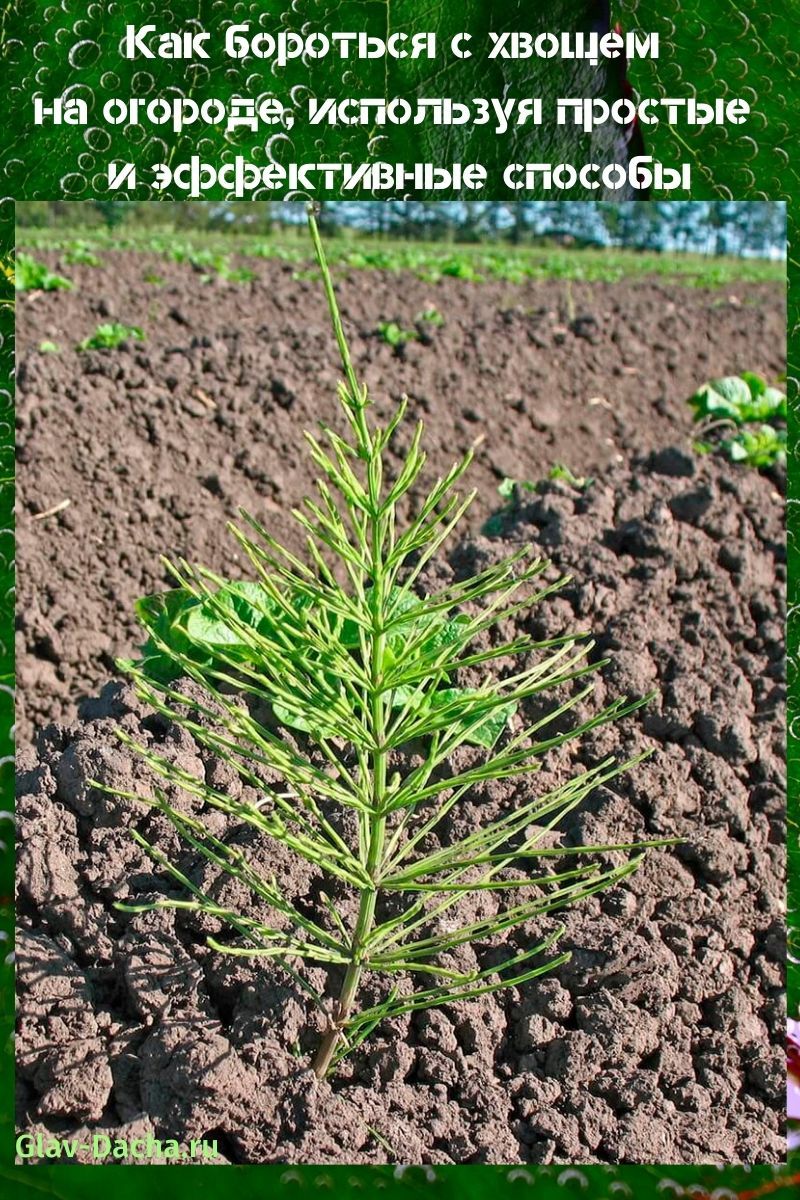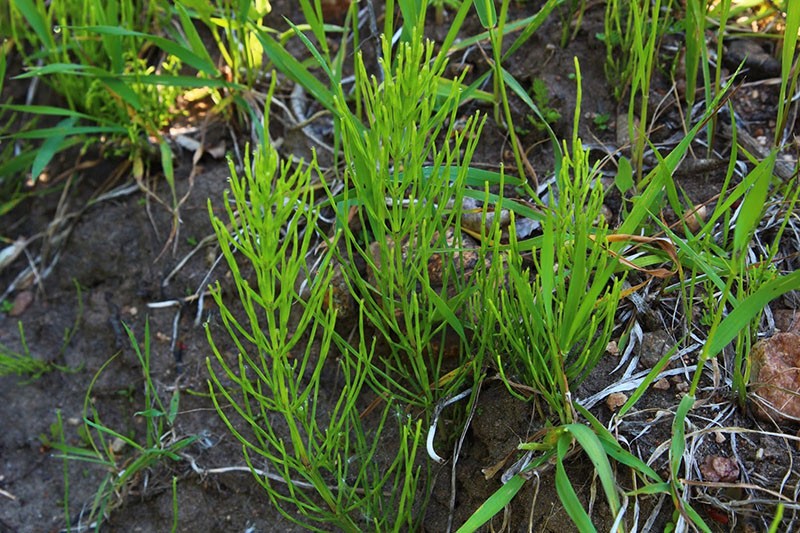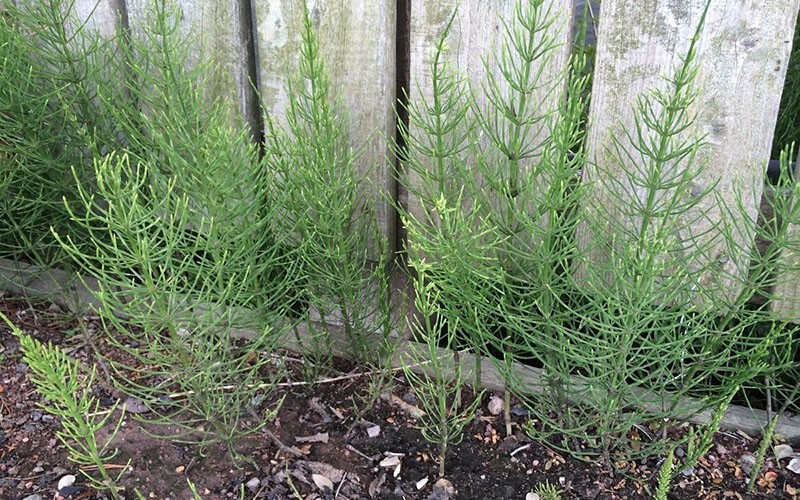How to deal with horsetail in the garden using simple and effective ways
 Horsetail is a noxious weed that can appear anywhere in your home garden and cause serious damage to crops. There are several effective ways to deal with horsetail in the garden - biological, chemical, and soil cultivation. The combination of several methods allows not only to get rid of the annoying weed, but also to prevent its reappearance on the site.
Horsetail is a noxious weed that can appear anywhere in your home garden and cause serious damage to crops. There are several effective ways to deal with horsetail in the garden - biological, chemical, and soil cultivation. The combination of several methods allows not only to get rid of the annoying weed, but also to prevent its reappearance on the site.
Horsetail harm

The main ways of horsetail penetration into the site:
- delivery of fresh soil with roots or weed spores to the site;
- distribution from neighboring territories;
- introduction of horsetail spores by wind or birds.
 In spring, horsetail forms erect stems of pinkish-lilac shade, on which spores form. During the summer, spore-bearing shoots are replaced by vegetative, abundantly covered with thin light green leaves.
In spring, horsetail forms erect stems of pinkish-lilac shade, on which spores form. During the summer, spore-bearing shoots are replaced by vegetative, abundantly covered with thin light green leaves.
The destruction of the horsetail can be a real problem for the summer resident, because this weed is distinguished by its extreme vitality and the ability to adapt to adverse conditions. It draws moisture and nutrients from the soil, depleting it. This leads to the fact that the growth of cultivated plants slows down, their productivity and decorativeness deteriorate.
How to deal with horsetail in the garden - effective methods
 If a field horsetail appears on a personal plot, the fight against it can be carried out in various ways. The most effective are biological and chemical methods of control.
If a field horsetail appears on a personal plot, the fight against it can be carried out in various ways. The most effective are biological and chemical methods of control.
Before fighting horsetail in the garden, it is imperative that the soil is pre-treated, preparing it for the next growing season. During spring and autumn digging of the soil, the roots of the horsetail are practically invisible.
In addition, they can reach 1.5 m in depth, and it is very difficult to dig a site to such a depth. Therefore, soil cultivation is carried out in a different way - by reducing its acidity.
Tillage
 In order to prevent the rapid growth of the weed, it is necessary to take into account the soil on which the horsetail grows. This plant prefers soils with high acidity and moisture. Therefore, to prevent the spread of horsetail, soil deoxidation is required.
In order to prevent the rapid growth of the weed, it is necessary to take into account the soil on which the horsetail grows. This plant prefers soils with high acidity and moisture. Therefore, to prevent the spread of horsetail, soil deoxidation is required.
Soil liming is a long process that can take several years. For this purpose, lime, wood ash or dolomite flour can be used.
Application dosages:
- lime - 600 g per 1 sq. m;
- wood ash - 550-750 g;
- dolomite flour - from 250 to 700 g, depending on the acidity of the soil.
 Most often, gardeners use dolomite flour. It not only effectively reduces the acidity of the soil, but also saturates it with calcium and magnesium. But in order for the fertilizer to be beneficial, you need to correctly calculate its rate - no more than 300 g for slightly acidic, 500 g for medium acidic and 700 g for acidic soil.
Most often, gardeners use dolomite flour. It not only effectively reduces the acidity of the soil, but also saturates it with calcium and magnesium. But in order for the fertilizer to be beneficial, you need to correctly calculate its rate - no more than 300 g for slightly acidic, 500 g for medium acidic and 700 g for acidic soil.
Lime gives the fastest possible result, but has an aggressive effect, impairing the absorption of phosphorus and nitrogen by plants.
When using wood ash, you can get not only a decrease in the acidity of the soil, but also its feeding and additional loosening. Ash can be applied immediately before digging the beds.
The deoxidizer must be scattered abundantly over the surface of the soil, then leveled and watered. The lime procedure is best done in the fall, after the harvest. When deoxidizing the soil in summer, you can burn the roots of cultivated plants.
Dolomite flour and ash can be used throughout the year, including in spring, 15-20 days before planting vegetables. The next year, you need to measure the acidity of the earth - if it remains elevated, the deoxidation should be repeated.
Chemical methods of struggle
 One of the most effective ways to remove field horsetail from the garden is to use special preparations. Chemicals are best used when there is extensive weed growth in the area.
One of the most effective ways to remove field horsetail from the garden is to use special preparations. Chemicals are best used when there is extensive weed growth in the area.
Horsetail is not a flowering plant, but a spore plant, therefore, it can only be eliminated with the help of powerful herbicides with a general exterminating effect. The usual preparations of the Tornado, Roundup and others used to control other weeds will not be beneficial in controlling horsetail.
Effective preparations for the destruction of horsetail:
- Agrokiller is a herbicide with minimal toxicity, designed to destroy field horsetail and other weeds. Agrokiller's active ingredients are quickly absorbed by the weed cells, penetrate into the root system and destroy it. Recommended dosage for 100 sq. m. - 45-50 ml for 3 water.

- Prima is one of the most potent selective herbicides. The active substances quickly penetrate into the cells of the weed, stopping its growth and development. The rate of the preparation is 450-600 ml per 1 ha.

- Ground - herbicide is used in a dosage of 100-120 ml per 10 liters of water. The solution is used to treat areas with weeds in spring, before planting vegetables, or in autumn, after harvesting.

Also, for the destruction of horsetail, you can use herbicides Zenkor, Lontrell-300, Stomp, Hurricane.
 The drugs Titus and Glyphos are considered no less effective. Titus is a potent herbicide that quickly penetrates into all parts of the horsetail and stops its further growth and development, providing a prolonged effect. Glyphos has a similar effect - it is a versatile herbicide resistant to any weather conditions.
The drugs Titus and Glyphos are considered no less effective. Titus is a potent herbicide that quickly penetrates into all parts of the horsetail and stops its further growth and development, providing a prolonged effect. Glyphos has a similar effect - it is a versatile herbicide resistant to any weather conditions.
Solutions are prepared according to the manufacturer's instructions. Do not exceed the indicated dosage, as herbicides can harm not only weeds, but also cultivated plants.
Biological methods of control
 Among the methods of how to fight horsetail in the garden, biological ones are especially popular. They do not harm the soil and are absolutely harmless to cultivated plants.
Among the methods of how to fight horsetail in the garden, biological ones are especially popular. They do not harm the soil and are absolutely harmless to cultivated plants.
The field horsetail does not tolerate the "neighborhood" with cruciferous plants - white mustard, oil radish, winter rape, and winter rye. Therefore, to protect the site from the appearance of horsetail in the fall, these crops can be sown after harvest.
Mulching the site is considered an effective biological method of combating horsetail.
Almost any organic material can be used as mulch - fine gravel, crushed tree branches, wood chips, grass cuttings. You can also use black agrofibre.
The mulching layer blocks the free access of oxygen and sunlight, which the horsetail needs for full growth and development. Also, mulch prevents the emergence of new shoots, stopping the spread of weeds on the site.
 Horsetail is one of the most dangerous and vicious weeds. It not only grows rapidly, occupying the entire free area of the site, but also draws moisture and nutrients from it, impairing the growth of cultivated plants.Horsetail control is best done in a holistic manner, combining effective biological and chemical methods with soil cultivation.
Horsetail is one of the most dangerous and vicious weeds. It not only grows rapidly, occupying the entire free area of the site, but also draws moisture and nutrients from it, impairing the growth of cultivated plants.Horsetail control is best done in a holistic manner, combining effective biological and chemical methods with soil cultivation.